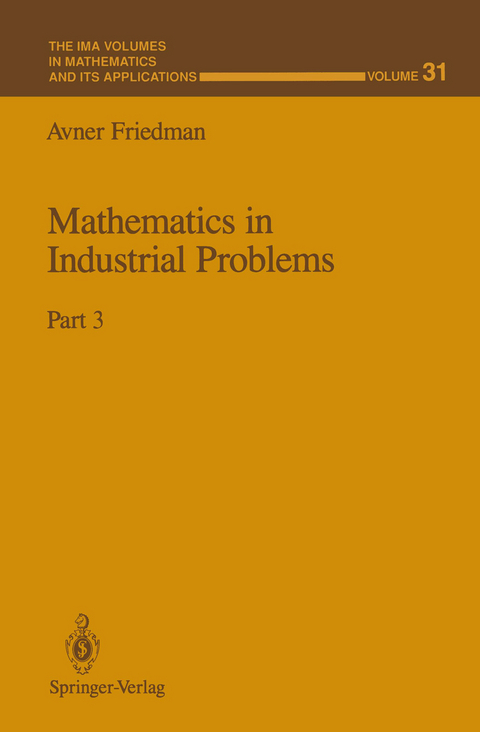
Mathematics in Industrial Problems
Springer-Verlag New York Inc.
978-1-4613-9100-5 (ISBN)
This is the third volume in the series "Mathematics in Industrial Prob lems." The motivation for these volumes is to foster interaction between Industry and Mathematics at the "grass roots"; that is, at the level of spe cific problems. These problems come from Industry: they arise from models developed by the industrial scientists in ventures directed at the manufac ture of new or improved products. At the same time, these problems have the potential for mathematical challenge and novelty. To identify such problems, I have visited industries and had discussions with their scientists. Some of the scientists have subsequently presented their problems in the IMA seminar on Industrial Problems. The book is based on questions raised in the seminar and subsequent discussions. Each chapter is devoted to one of the talks and is self-contained. The chap ters usually provide references to the mathematical literature and a list of open problems which are of interest to the industrial scientists. For some problems partial solution is indicated briefly. The last chapter of the book contains a short description of solutions to some of the problems raised in the second volume, as well as references to papers in which such solutions have been published.
1 Internal Oxidation of Binary Alloys.- 1.1 The model.- 1.2 The bifurcation diagram.- 1.3 Open problems.- 1.4 References.- 2 Fundamental Problems in the Theory of Shaped-Charged Jets.- 2.1 Formation of jets.- 2.2 Penetration of jets.- 2.3 Open problems.- 2.4 References.- 3 Mathematical Modeling of Dielectric Waveguides.- 3.1 Waveguide.- 3.2 Maxwell’s equations.- 3.3 Homogeneous waveguide analysis; normal modes.- 3.4 Inhomogeneous waveguide analysis: beam propagation technique.- 3.5 Electro-optic switch.- 3.6 Open problems and suggestions.- 3.7 References.- 4 A diffusion problem from rock porosity measurements.- 4.1 The model.- 4.2 Problems.- 4.3 References.- 5 Applications and modeling of diffractive optical elements.- 5.1 Overview of the technology.- 5.2 Need for mathematical modeling.- 5.3 Mathematical approach based on the Maxwell equations.- 5.4 References.- 6 An approach to optimal classification.- 6.1 Objects and probabilities of detection.- 6.2 An optimization procedure.- 6.3 Data fusion.- 6.4 Open questions.- 6.5 References.- 7 Polymer-dispersed liquid crystal films for light control.- 7.1 Operation and measurements.- 7.2 Scattering by a single optically isotropic particle.- 7.3 Light scattering from nematic droplets.- 7.4 Suggestions.- 7.5 References.- 8 Singularity problems in the stress analysis of semiconductor packaging.- 8.1 Semiconductor final manufacturing.- 8.2 Mathematical formulation.- 8.3 Numerical methods.- 8.4 Partial solution.- 8.5 References.- 9 Pulse reflection from a randomly stratified medium.- 9.1 The direct analysis.- 9.2 The inverse problem.- 9.3 References.- 10 Theory of polymer melt viscoelasticity.- 10.1 Polymers.- 10.2 The Doi—Edwards theory.- 10.3 Beyond the Doi—Edwards model.- 10.4 Constraint release and polydispersity.- 10.5References.- 11 The Advection Equation in Air Quality Modeling.- 11.1 The general model.- 11.2 The advection equation.- 11.3 Numerical methods for the advection equation.- 11.4 Open problems.- 11.5 Remarks on Problem (1).- 11.6 References.- 12 Diffusion in swelling media: modeling and applications.- 12.1 Thermal dye transfer.- 12.2 Gelatin swelling; filter dye deposition.- 12.3 Open problems.- 12.4 Solution to Problem (1).- 12.5 References.- 13 Mathematical modeling of semiconductor lasers.- 13.1 The electrical model.- 13.2 Optical/electrical link.- 13.3 Simplifying (13.5)–(13.15).- 13.4 References.- 14 Conformation of random polymers.- 14.1 Phenomenology.- 14.2 The excluded volume problem.- 14.3 Protein and polyamphilytes.- 14.4 References.- 15 Current-voltage relations for electrolytic solutions.- 15.1 An electrochemical system.- 15.2 Mathematical formulation.- 15.3 Solution methods.- 15.4 Open problems.- 15.5 Comments on Problem (1).- 15.6 References.- 16 Scaling and Optimization for List-Matching.- 16.1 Formulation.- 16.2 The partition function.- 16.3 The traveling salesman algorithm.- 16.4 References.- 17 Topics in Tomography.- 17.1 “Tomography cannot work”.- 17.2 Mathematical phantom.- 17.3 Radon’s transform; algorithms.- 17.4 Reconstruction from partial view.- 17.5 References.- 18 Solution to problems from Part 2.- 18.1 References.
| Reihe/Serie | The IMA Volumes in Mathematics and its Applications ; 31 |
|---|---|
| Zusatzinfo | XIII, 187 p. |
| Verlagsort | New York, NY |
| Sprache | englisch |
| Maße | 155 x 235 mm |
| Themenwelt | Informatik ► Theorie / Studium ► Künstliche Intelligenz / Robotik |
| Mathematik / Informatik ► Mathematik ► Angewandte Mathematik | |
| Naturwissenschaften ► Chemie ► Physikalische Chemie | |
| Technik | |
| ISBN-10 | 1-4613-9100-8 / 1461391008 |
| ISBN-13 | 978-1-4613-9100-5 / 9781461391005 |
| Zustand | Neuware |
| Informationen gemäß Produktsicherheitsverordnung (GPSR) | |
| Haben Sie eine Frage zum Produkt? |
aus dem Bereich


